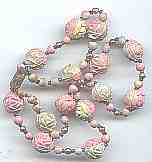Your path =Home>Beadmaking & Materials>Organic Materials> Rose Petals
How to Make Rose Petal Beads
By Diane Merrill
FOREWORD: People are always asking me for a good rose petal bead recipe. I don't have one. I have recipes and I've tried one, but it didn't do anything. I have a friend (she knows who she is) who claims to have the perfect recipe, but she doesn't give it out
|
||||||
Do not use roses that have been sprayed with anything. Do not use roses that have been fertilized with a systemic pesticide. Know where your roses come from. This is essential. Your neighborhood is now safe from predatory artisans filching fading or dying blooms.
The white base of each petal is tough and makes for an inconsistent texture, so many people specify to remove this. I don't and have had no problems. You grind up the petals in a food processor (or blender, meat grinder, mortar and pestle, or with a knife) until they are fragments like couscous.1 That is, tiny.
|
I have always used a cast iron frying pan for simmering because the original directions told me to -- something about iron and chemistry that to this day I can't remember. Enamel prevents discoloration, iron creates it. The petals get very dark and I want that. (Someday I will try a pink petal with an enameled pan and see if the color is retained but many petals get a yucky dead-leaf color.)
Simmer for an hour. Turn it off and let it cool. Simmer for another hour. Turn it off. Do this several times and the petals will lose all resistance (wouldn't we all) and turn into a soft mass (mess). This makes your house smell like roses. What a surprise!
Take the rose pulp and put it through a fine sieve, squishing (this is a technical term) the petals against the sieve to remove as much water as possible. Save the liquid for cooking (I have a medieval recipe for a rose-lemonade-like cold drink if you want it. Very elegant!)
Now for the bead forming.
Pinch off a bit of the mass and roll and compress it into a ball. The contraction ratio during drying is about 50% by the way, so a marble sized ball at this stage is not too big.
You can press the mass between your thumbs and index fingers and get a square bead if you are ambitious. In any case forming the stuff into shapes works a lot like clay. (It actually holds together. I didn't think it would but it gets very hard.)
Place the shapes on paper towels for a day or so. The time varies wildly with the humidity and where you are. They need to be pierced with a wire while still wet but dry enough so this operation will not distort their shape.
I string many of the pierced beads on one wire leaving spaces so that they don't touch. I then hang this wire (many wires actually) on a grill in the oven to let them dry at a very low temperature. Too high a temperature and they will burn and lose their scent and color. Too low and they will take forever to dry and become moldy.
Once they are dry, they are as hard as an unsoaked kidney bean (or my heart). When dry they can be eased off the wire and strung as you choose.
I take sterling silver wire and make a loop at each end with the rose petal bead in the middle. This means they can be hung as earrings or as a necklace link without further handling of the bead, since everyone says are so fragile. (Do not wear when swimming).
Some folks roll them in scented oil. Some varnish them. I don't. Some people say that additives such as oris root and gum arabic enhance their durability and prolong their scent. I haven't used these.
I have also been advised by a very wise person that these need to be stored in a tight container to retain their scent. They also pick up nearby odors. Don't put them near your fishing tackle or ashtray.
Here is my recipe so far. The yield is terrific. The liquid has lovely secondary uses.
Ó 2000 Diane Merrill
1 Couscous (real name: seksu) is a Moroccan dish made by forming tiny balls of flour between the palms of the hands. It is then steamed and considered a great delicacy. Consider this to be about a quarter of the size of an uncooked grain of rice.
__________________________________________________
Small Bead Businesses | Beading & Beadwork | Ancient Beads | Trade Beads
Beadmaking & Materials | Bead Uses | Researching Beads | Beads and People
Center for Bead Research | Book Store | Free Store | Bead Bazaar
Shopping Mall | The Bead Auction | Galleries | People | Events
The Bead Site Home | Chat Line | Contact Us | Site Search Engine | FAQ


